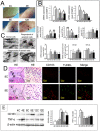The identification of CD163 expressing phagocytic chondrocytes in joint cartilage and its novel scavenger role in cartilage degradation
- PMID: 23326413
- PMCID: PMC3543453
- DOI: 10.1371/journal.pone.0053312
The identification of CD163 expressing phagocytic chondrocytes in joint cartilage and its novel scavenger role in cartilage degradation
Abstract
Background: Cartilage degradation is a typical characteristic of arthritis. This study examined whether there was a subset of phagocytic chondrocytes that expressed the specific macrophage marker, CD163, and investigated their role in cartilage degradation.
Methods: Cartilage from the knee and temporomandibular joints of Sprague-Dawley rats was harvested. Cartilage degradation was experimentally-induced in rat temporomandibular joints, using published biomechanical dental methods. The expression levels of CD163 and inflammatory factors within cartilage, and the ability of CD163(+) chondrocytes to conduct phagocytosis were investigated. Cartilage from the knees of patients with osteoarthritis and normal cartilage from knee amputations was also investigated.
Results: In the experimentally-induced degrading cartilage from temporomandibular joints, phagocytes were capable of engulfing neighboring apoptotic and necrotic cells, and the levels of CD163, TNF-α and MMPs were all increased (P<0.05). However, the levels of ACP-1, NO and ROS, which relate to cellular digestion capability were unchanged (P>0.05). CD163(+) chondrocytes were found in the cartilage mid-zone of temporomandibular joints and knee from healthy, three-week old rats. Furthermore, an increased number of CD163(+) chondrocytes with enhanced phagocytic activity were present in Col-II(+) chondrocytes isolated from the degraded cartilage of temporomandibular joints in the eight-week experimental group compared with their age-matched controls. Increased number with enhanced phagocytic activity of CD163(+) chondrocytes were also found in isolated Col-II(+) chondrocytes stimulated with TNF-α (P<0.05). Mid-zone distribution of CD163(+) cells accompanied with increased expression of CD163 and TNF-α were further confirmed in the isolated Col-II(+) chondrocytes from the knee cartilage of human patients with osteoarthritis, in contrast to the controls (both P<0.05).
Conclusions: An increased number of CD163(+) chondrocytes with enhanced phagocytic activity were discovered within degraded joint cartilage, indicating a role in eliminating degraded tissues. Targeting these cells provides a new strategy for the treatment of arthritis.
Conflict of interest statement
Figures







Similar articles
-
Anabolic role of lysyl oxidase like-2 in cartilage of knee and temporomandibular joints with osteoarthritis.Arthritis Res Ther. 2017 Aug 2;19(1):179. doi: 10.1186/s13075-017-1388-8. Arthritis Res Ther. 2017. PMID: 28764769 Free PMC article.
-
Matrix replenishing by BMSCs is beneficial for osteoarthritic temporomandibular joint cartilage.Osteoarthritis Cartilage. 2017 Sep;25(9):1551-1562. doi: 10.1016/j.joca.2017.05.007. Epub 2017 May 19. Osteoarthritis Cartilage. 2017. PMID: 28532603
-
Syndecan-4 inhibition attenuates cartilage degeneration in temporomandibular joint osteoarthritis.J Oral Rehabil. 2024 Nov;51(11):2324-2335. doi: 10.1111/joor.13829. Epub 2024 Aug 5. J Oral Rehabil. 2024. PMID: 39101668
-
Cartilage degeneration in different human joints.Osteoarthritis Cartilage. 2005 Feb;13(2):93-103. doi: 10.1016/j.joca.2004.11.006. Osteoarthritis Cartilage. 2005. PMID: 15694570 Review.
-
Synovial microenvironment in temporomandibular joint osteoarthritis: crosstalk with chondrocytes and potential therapeutic targets.Life Sci. 2024 Oct 1;354:122947. doi: 10.1016/j.lfs.2024.122947. Epub 2024 Aug 8. Life Sci. 2024. PMID: 39117138 Review.
Cited by
-
Pleiotrophin, the angiogenic and mitogenic growth factor: levels in serum and synovial fluid in rheumatoid arthritis and osteoarthritis : And correlation with clinical, laboratory and radiological indices.Z Rheumatol. 2018 May;77(4):322-329. doi: 10.1007/s00393-016-0234-8. Z Rheumatol. 2018. PMID: 27904997 English.
-
Microenvironment in subchondral bone: predominant regulator for the treatment of osteoarthritis.Ann Rheum Dis. 2021 Apr;80(4):413-422. doi: 10.1136/annrheumdis-2020-218089. Epub 2020 Nov 6. Ann Rheum Dis. 2021. PMID: 33158879 Free PMC article. Review.
-
β2-Adrenergic signal transduction plays a detrimental role in subchondral bone loss of temporomandibular joint in osteoarthritis.Sci Rep. 2015 Jul 29;5:12593. doi: 10.1038/srep12593. Sci Rep. 2015. PMID: 26219508 Free PMC article.
-
Activation of α2A-adrenergic signal transduction in chondrocytes promotes degenerative remodelling of temporomandibular joint.Sci Rep. 2016 Jul 25;6:30085. doi: 10.1038/srep30085. Sci Rep. 2016. PMID: 27452863 Free PMC article.
-
Expression Profile of New Gene Markers Involved in Differentiation of Canine Adipose-Derived Stem Cells into Chondrocytes.Genes (Basel). 2022 Sep 16;13(9):1664. doi: 10.3390/genes13091664. Genes (Basel). 2022. PMID: 36140831 Free PMC article.
References
Publication types
MeSH terms
Substances
LinkOut - more resources
Full Text Sources
Other Literature Sources
Research Materials
Miscellaneous

